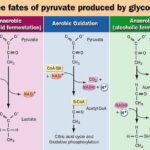Energy relations- Number of ATP molecules generated
Energy relations- Number of ATP molecules generated
Please login to submit an answer.
Glycolysis operates in the cytoplasm and converts one molecule of glucose into two molecules of pyruvate, producing a net of 2 ATP molecules via substrate-level phosphorylation and 2 NADH molecules that feed into oxidative phosphorylation
investment phase consumes 2 ATP, payoff phase generates 4 ATP
net yield per glucose: 2 ATP, 2 NADH
Pyruvate dehydrogenase reaction (link reaction) converts 2 pyruvate into 2 acetyl-CoA but does not directly produce ATP; it generates 2 NADH for use in the electron transport chain
Krebs (citric acid) cycle occurs in the mitochondrial matrix, turning each acetyl-CoA into CO₂ and capturing energy in 3 NADH, 1 FADH₂, and 1 GTP (equivalent to ATP); per glucose this yields 2 ATP (as GTP), 6 NADH, and 2 FADH₂
net yield per glucose: 2 GTP (≈2 ATP), 6 NADH, 2 FADH₂
Oxidative phosphorylation (electron transport chain plus chemiosmosis) uses reduced cofactors to drive ATP synthase; theoretical yield per glucose:
each NADH yields ~2.5 ATP
each FADH₂ yields ~1.5 ATP
overall theoretical ATP from NADH and FADH₂: (10 NADH × 2.5) + (2 FADH₂ × 1.5) = 28 ATP
plus 4 ATP (2 from glycolysis, 2 from Krebs) gives theoretical maximum of 32 ATP per glucose
Practical ATP yield per glucose under typical cellular conditions is approximately 29–30 ATP due to proton leak and transport costs
Immediate energy system (ATP–phosphocreatine) provides rapid ATP regeneration in muscles for ~10 seconds of high-intensity activity; one molecule of phosphocreatine regenerates one ATP via creatine kinase, but total phosphocreatine stores yield only ~1–2 seconds worth of maximal effort
Anaerobic glycolysis (lactic acid system) supplies ATP for activities lasting up to ~2 minutes, yielding 2 ATP per glucose and causing lactate accumulation; important for short, intense efforts but limited by low ATP yield and acid build-up
Aerobic (oxidative) system dominates after ~2 minutes of exercise, oxidizing carbohydrates, fats, and (to a lesser extent) amino acids to generate ATP; yield per substrate:
glucose (aerobic glycolysis + Krebs + oxidative phosphorylation): ~29–30 ATP per glucose
palmitic acid (16-carbon fatty acid): ~106 ATP after β-oxidation and complete oxidation in Krebs and oxidative phosphorylation
amino acids enter as pyruvate, acetyl-CoA, or Krebs intermediates, yielding variable ATP depending on the residue (generally less preferred due to protein catabolism)
ATP yield efficiencies and system contributions can be mapped to exercise intensity and duration, informing training and recovery strategies for athletes and clinical rehabilitation
high-intensity, short-duration: ATP–PCr system (1 ATP/PCr)
moderate-intensity, medium-duration: anaerobic glycolysis (2 ATP/glucose)
low-intensity, long-duration: oxidative phosphorylation (≈29–30 ATP/glucose; ≈106 ATP/palmitate)
- Share on Facebook
- Share on Twitter
- Share on LinkedIn
Helpful: 0%




